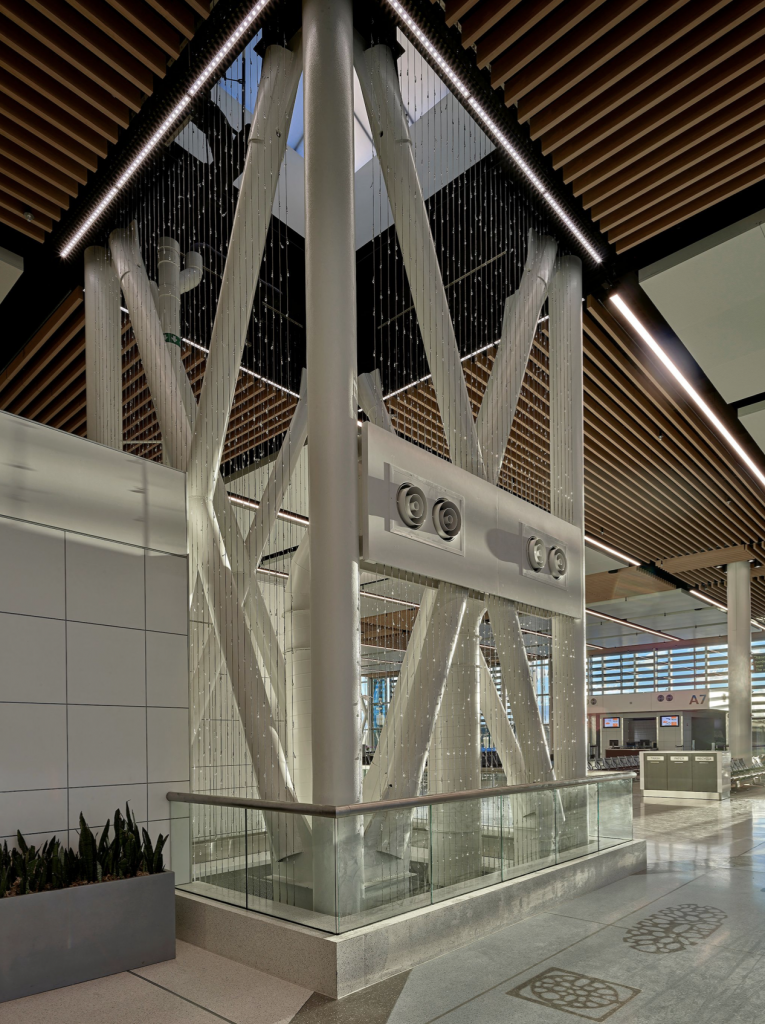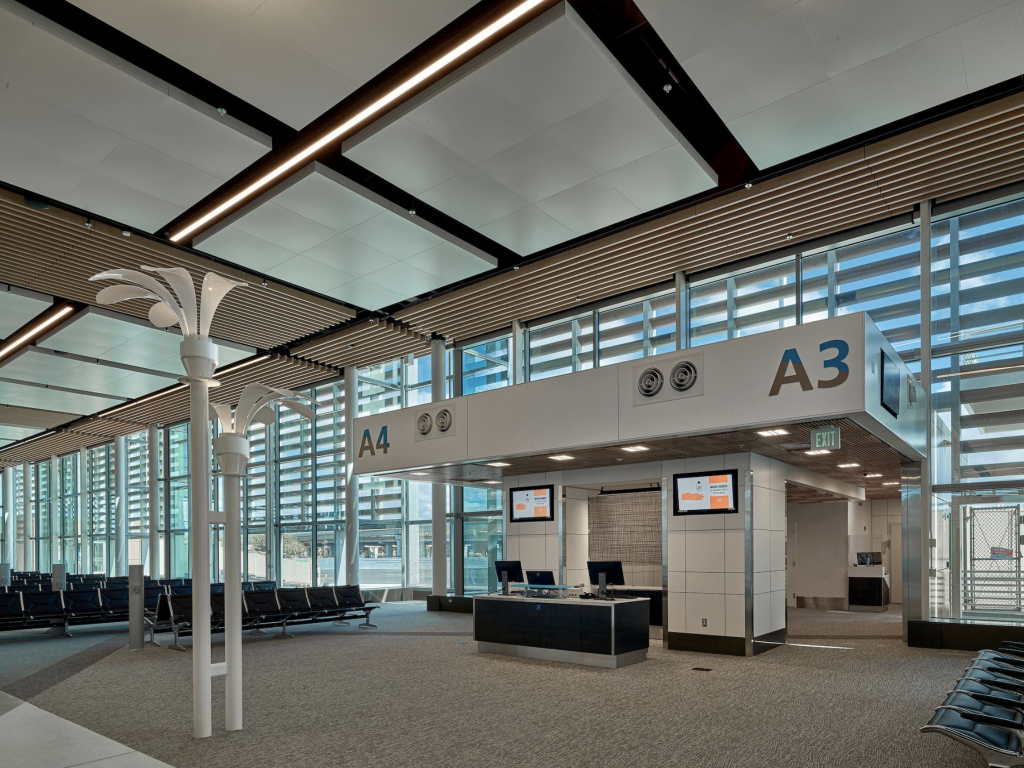New Honolulu Airport Concourse Design Highlights Hawai‘i’s Sense of Place

Understated elegance is how Carol Torigoe, president and CEO of KYA Design Group, describes the architectural layout and design elements of the new Mauka Concourse at the Daniel K. Inouye International Airport in Honolulu.
KYA and a team of consultants provided a full range of design services for the first major gate expansion at Hawaiʻi’s largest airport since 1993, starting from developing the architectural and engineering plans to overseeing the three-year construction process to build the facility.
Connected to Terminal 1 on the mauka (mountain) side of the airport, the Mauka Concourse can accommodate up to six wide-body aircraft or 11 narrow-body aircraft serving interisland and domestic flights, as well as international departures.
Since the state-of-the art, 230,000 sq. ft. facility opened on Aug. 27, airport officials said the public response has been favorable with both travelers and workers impressed by the unique design features and also how it has improved the airport’s operations.
“The new terminal has enabled the airport to greatly enhance the flow and servicing of travelers, especially during the peak mid-day period when numerous flights are arriving and departing at our state’s busiest airport,” said Ross Higashi, deputy director of the Hawaiʻi Department of Transportation Airports Division. “We also appreciate how the design honors the culture of Hawaiʻi and the qualities that make being in the islands such an enjoyable experience.”
Torigoe noted the Mauka Concourse is an innovative combination of operational flexibility, energy efficiency, culture, and a design concept highlighting Hawaiʻi’s appealing characteristics, most notably the beautiful skies and how the colors change throughout the day.
“Our team designed the Mauka Concourse to showcase what’s important to the people of Hawaiʻi,” said Torigoe. “There is a balance of natural light, of culture, and of openness that helps make the airport experience relaxing and enjoyable. These are qualities people want to experience when they are getting ready to board a flight or returning home to the islands.”
Upon entering the Mauka Concourse, travelers will appreciate the ease of access as six new TSA security screening lanes have been installed to screen passengers. Then, the facility’s spaciousness immediately becomes apparent and the outdoor views an attraction, due to the 25-foot-tall ceilings and floor-to-ceiling glass walls on all sides.
To keep the outdoor views free from being obstructed, KYA’s design has the food and beverage outlets, retail shops, and restrooms located in the core of the concourse.
“Everywhere in the facility, the sight of Hawaiʻi’s beautiful skies, from sunrise to sunset and into the evening, are expansive and ever-present,” said Torigoe. “We like to think of this design concept as people relaxing on their lanai and enjoying the views.”
Honoring Hawaiʻi Through Exhibits and Art
A special display everyone will pass by upon entering the concourse is an exhibit honoring the late Senator Daniel K. Inouye, who the airport is named after. The exhibit features his work desk and other artifacts from his lifetime of service for the people of Hawaiʻi.
A decorated World War II veteran who fought in the U.S. Army’s famed 442nd Infantry Regiment and received the Congressional Medal of Honor, Senator Inouye served Hawaiʻi in Congress in the United States House of Representatives from 1959 to 1963 and in the United States Senate from 1963 until his passing in 2012.
As travelers move throughout the concourse, they will notice custom artwork and finishes that honor Hawaiʻi’s culture and complement the contemporary Hawaiian aviation concept. Being the airport’s northernmost concourse, the cultural design elements are a tribute to the Waialua Moku, the northernmost district on Oahu.
An abundance of natural materials is coupled with a variety of native island textures and patterns to help comfort and relax travelers. One special design feature in the gate areas are light fixtures in the shape of the Naupaka flower, which is common to Waialua.
Torigoe added that the concept of sky, land and sea is also captured in the interior features and finishes, particularly the eco-shaft columns that extend upward to the ceiling to support the entire structure and skylights. The eco-shafts signify the mountains reaching up to the sky, with strings of glass beads between them representing waterfalls descending to the ocean-colored flooring.
Sustainable Design and Energy Efficiency
The eco-shafts are also the key structural component to the overall design of the Mauka Concourse, providing the necessary base for support while also serving as ventilation shafts to cool its interior. The eco-shafts are more than just a replacement for interior load bearing walls – they free up space that contributes to the sense of openness throughout the facility.
Additionally, the mechanical room providing the facility’s air conditioning is located on the ground floor, instead of the roof, as is often the case in other structures. The cool air is thereby circulated at the level closer to where people are moving about the facility, instead of coming from the ceiling. It’s more efficient to keep people comfortable without having to cool the facility’s entire volume.
Torigoe said, “We set out to design a concourse for the future, and the key factor to achieving that was flexibility with its operations and usage. With the eco-shafts, we have a strong structural system in place with minimal columns and no bearing walls.
“This also allowed us to design a new kind of passenger terminal that speaks to the truest sense of place about Hawaii, a desire for open views in all directions and an uncrowded setting that encourages people to relax and enjoy life.”



















